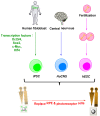Recent Advances in Age-Related Macular Degeneration Therapies
- PMID: 36014339
- PMCID: PMC9414333
- DOI: 10.3390/molecules27165089
Recent Advances in Age-Related Macular Degeneration Therapies
Abstract
Age-related macular degeneration (AMD) was described for the first time in the 1840s and is currently the leading cause of blindness for patients over 65 years in Western Countries. This disease impacts the eye's posterior segment and damages the macula, a retina section with high levels of photoreceptor cells and responsible for the central vision. Advanced AMD stages are divided into the atrophic (dry) form and the exudative (wet) form. Atrophic AMD consists in the progressive atrophy of the retinal pigment epithelium (RPE) and the outer retinal layers, while the exudative form results in the anarchic invasion by choroidal neo-vessels of RPE and the retina. This invasion is responsible for fluid accumulation in the intra/sub-retinal spaces and for a progressive dysfunction of the photoreceptor cells. To date, the few existing anti-AMD therapies may only delay or suspend its progression, without providing cure to patients. However, in the last decade, an outstanding number of research programs targeting its different aspects have been initiated by academics and industrials. This review aims to bring together the most recent advances and insights into the mechanisms underlying AMD pathogenicity and disease evolution, and to highlight the current hypotheses towards the development of new treatments, i.e., symptomatic vs. curative. The therapeutic options and drugs proposed to tackle these mechanisms are analyzed and critically compared. A particular emphasis has been given to the therapeutic agents currently tested in clinical trials, whose results have been carefully collected and discussed whenever possible.
Keywords: age-related maculopathy; clinical trials; dry age-related macular degeneration; elderly; eye’s disease; wet age-related macular degeneration.
Conflict of interest statement
The authors declare no conflict of interest.
Figures























References
-
- Forrester J.V., Dick A.D., McMenamin P.G., Roberts F., Pearlman E. The Eye. Elsevier; Amsterdam, The Netherlands: 2016. Biochemistry and Cell Biology; pp. 157–268.e4.
-
- Cholkar K., Dasari S.R., Pal D., Mitra A.K. Ocular Transporters and Receptors: Their Role in Drug Delivery. Elsevier Ltd.; Amsterdam, The Netherlands: 2013. Eye: Anatomy, Physiology and Barriers to Drug Delivery; pp. 1–36.
-
- Moschos M.M., Nitoda E., Chatziralli I.P., Demopoulos C.A. Age-Related Macular Degeneration: Pathogenesis, Genetic Background, and the Role of Nutritional Supplements. J. Chem. 2014;2014:317536. doi: 10.1155/2014/317536. - DOI
-
- Eye Care, Vision Impairment and Blindness. [(accessed on 25 April 2022)]. Available online: https://www.who.int/health-topics/blindness-and-vision-loss#tab=tab_1.
Publication types
MeSH terms
Grants and funding
LinkOut - more resources
Full Text Sources
Medical

